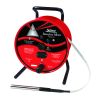Solinst Model 122M Mini Oil/Water Interface Meters
Features
- Sensor accuracy to 1/200 ft or 1.0 mm
- Easy access battery: minimum 300 hours of life
- Certified intrinsically safe
- Free ground shipping
- Expedited repair and warranty service
- Lifetime technical support
- More
Overview
The Solinst Mini Oil/Water Interface Meters give clear and accurate measurements of product level and thickness in wells and tanks. Determination of both light (floating) non-aqueous phase liquids (LNAPL) and dense (sinking) non-aqueous phase liquids (DNAPL) is quick and easy.
Design
The Model 122M Mini Interface Meter with PVDF laser marked cable is a convenient small version, which can easily to fit in a backpack, or an optional custom mini carry case. It uses narrow laser marked PVDF cable, in 80 ft or 25m lengths. The Mini Interface Meter enhanced electronics include automatic circuitry testing; 300 hours of on-time battery life; clear signals; and high accuracy. The circuits are powered by one standard 9V battery housed in easy-access drawer in the faceplate.
Mechanics
The 122M uses the P8 Probe, which is 5/8" in diameter (16mm) and stainless steel construction. It is pressure proof up to 500 psi. The beam is emitted from within a Hydex cone-shaped tip. The tip is protected by an integral stainless steel shield, and is excellent for the vast majority of product monitoring situations. The 0.12" (3mm) coaxial cable has a durable PVDF jacket with permanent laser markings every 1/100 ft. or each millimeter. The cable has a braided copper outer conductor, a stranded stainless steel central conductor, and a smooth chemical-resistant surface that is easy to decontaminate.
In The News
Three Decades of Research at Acton Lake
A multi-disciplinary team at Miami University, Ohio, has been studying the environmental change at Acton Lake for over three decades. Using three different NexSens buoys over this time, the team has an incredible archive of data that is helping build a picture of Acton’s past, present, and future. Until recently, a NexSens CB-50 buoy was used alongside other environmental monitoring at Acton Lake. In May 2025, the Miami team deployed a new XB-200 buoy , future-proofing their ongoing monitoring using real-time buoy systems. Acton Lake, a small hypereutrophic reservoir in southwest Ohio, covers 2.4km² and has a maximum depth of about 8m. The dam was built in 1956, and the lake has a large agricultural watershed.
Read MoreSource Water Monitoring in Albany, New York: Tracing Water Quality throughout Tributaries
Thousands of US cities pull their drinking water from natural source waters like reservoirs, rivers, and streams, making overall watershed health a key consideration for water providers. In Albany, New York, the Albany Department of Water and Water Supply delivers drinking water to over 100,000 residents as well as monitors and manages the larger drinking water supply watershed. Hannah Doherty, Environmental Specialist at the Albany Department of Water and Water Supply , spends her days working with a small team to monitor the drinking supply and the connected water bodies. Doherty explains, “We’re the first to encounter the water that ends up being the drinking water.
Read MoreWildfire Prevention in the Sierra Nevada Region with the Yuba Watershed Institute
Though recent wildfires have sparked new conversations about wildfire management and response, groups like the Yuba Watershed Institute have been monitoring the forests and water resources of the Sierra Nevada region for decades, managing approximately 5,000 acres of land with the Bureau of Land Management (BLM) and about 7,000 acres in private land partnerships. The goal of the Institute is to work with local communities and land agencies to improve watershed and forestry management through informed practices and public outreach. The goals of the Yuba Watershed Institute are three-fold: Improve the ability of fire suppression agencies like the California Department of Forestry and Fire Protection ( CAL FIRE ) and the US Forest Service.
Read More









